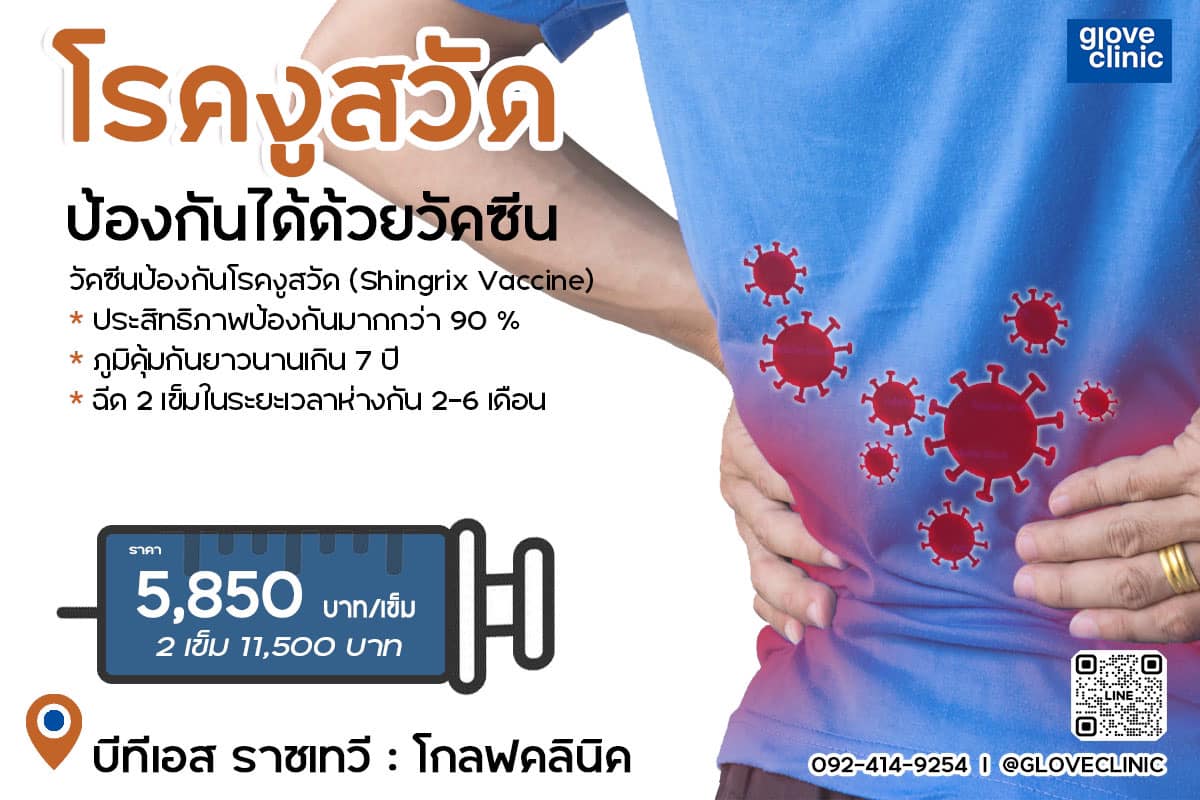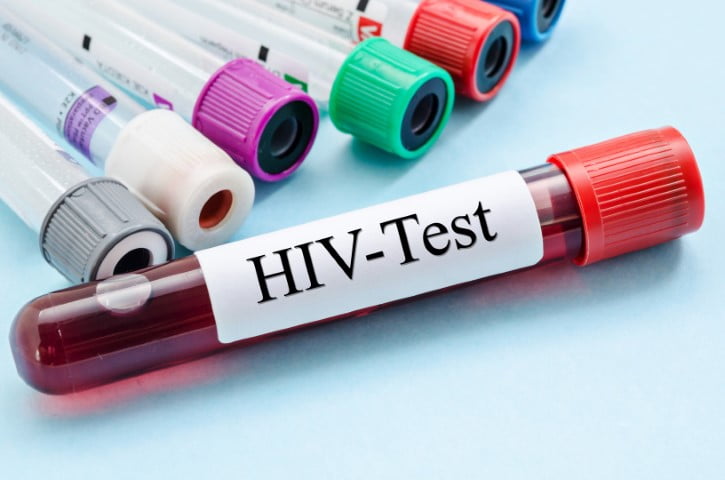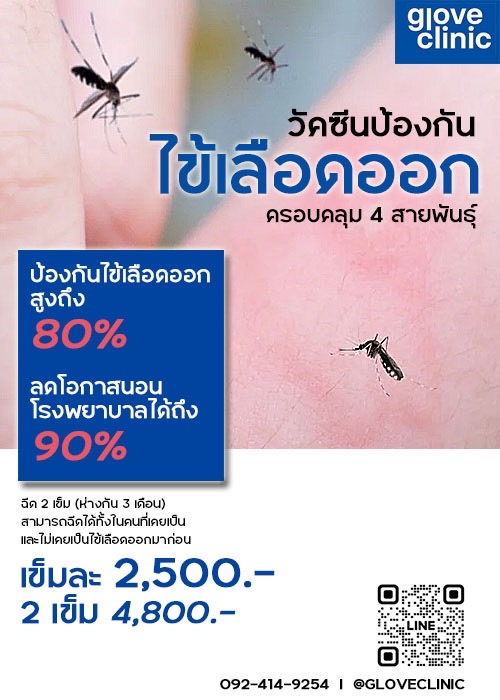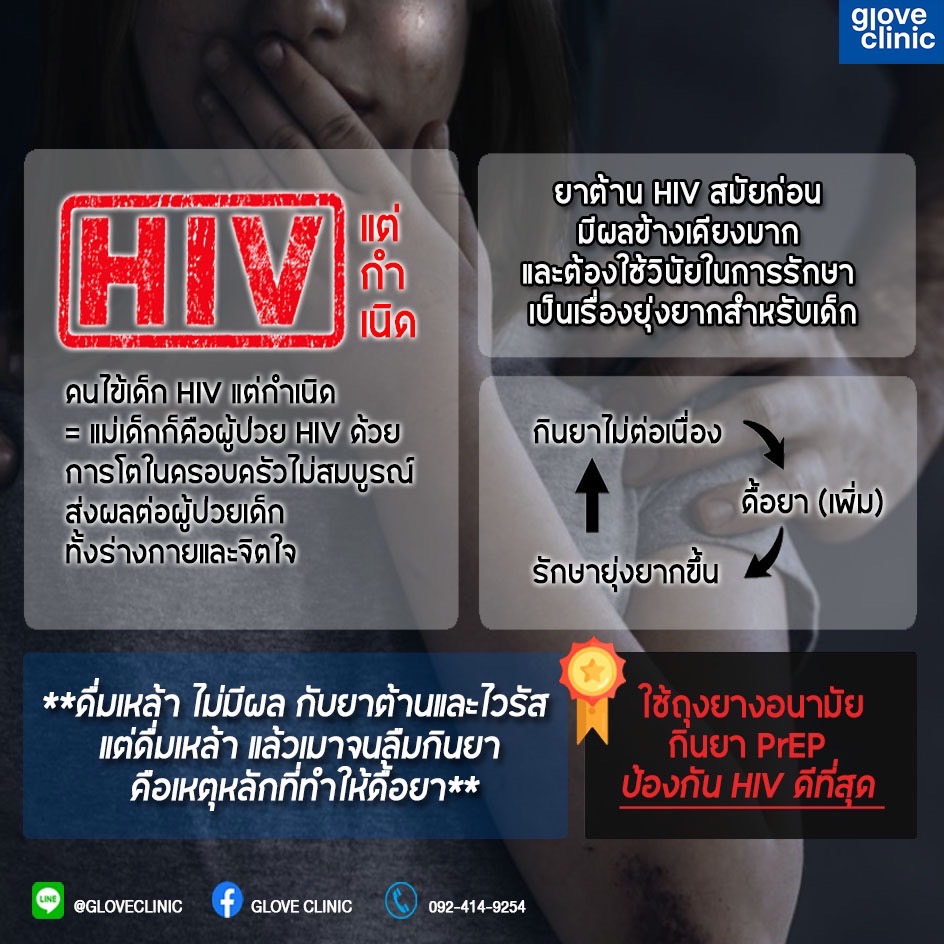294/1 Asia Building (11th Floor), Phyathai, Bangkok
Genital Herpes

What is genital herpes?
Genital herpes is a sexually transmitted disease (STD) caused by the herpes simplex virus type 1 (HSV-1) or type 2 (HSV-2).
How do people get genital herpes?
Infections are transmitted through contact with HSV in herpes lesions, mucosal surfaces, genital secretions, or oral secretions. HSV-1 and HSV-2 can be shed from normal-appearing oral or genital mucosa or skin. Generally, a person can only get HSV-2 infection during genital contact with someone who has a genital HSV-2 infection.
However, receiving oral sex from a person with an oral HSV-1 infection can result in getting a genital HSV-1 infection. Transmission commonly occurs from contact with an infected partner who does not have visible lesions and who may not know that he or she is infected. In persons with asymptomatic HSV-2 infections, genital HSV shedding occurs on 10.2% of days, compared to 20.1% of days among those with symptomatic infections.
What are the symptoms of genital herpes?
Most individuals infected with HSV are asymptomatic or have very mild symptoms that go unnoticed or are mistaken for another skin condition. When symptoms do occur, herpes lesions typically appear as one or more vesicles, or small blisters, on or around the genitals, rectum or mouth. The average incubation period for an initial herpes infection is 4 days (range, 2 to 12) after exposure. The vesicles break and leave painful ulcers that may take two to four weeks to heal after the initial herpes infection. Experiencing these symptoms is referred to as having a first herpes “outbreak” or episode.
Clinical manifestations of genital herpes differ between the first and recurrent (i.e., subsequent) outbreaks. The first outbreak of herpes is often associated with a longer duration of herpetic lesions, increased viral shedding (making HSV transmission more likely) and systemic symptoms including fever, body aches, swollen lymph nodes, or headache. Recurrent outbreaks of genital herpes are common, and many patients who recognize recurrences have prodromal symptoms, either localized genital pain, or tingling or shooting pains in the legs, hips or buttocks, which occur hours to days before the eruption of herpetic lesions. Symptoms of recurrent outbreaks are typically shorter in duration and less severe than the first outbreak of genital herpes.
How is genital herpes diagnosed?
The preferred HSV tests for patients with active genital ulcers are detection of HSV DNA by nucleic acid amplification tests such as polymerase chain reaction (PCR), or isolation by viral culture. HSV culture requires collection of a sample from the lesion and, once viral growth is seen, specific cell staining to differentiate between HSV-1 and HSV-2. PCR is more sensitive, allows for more rapid and accurate results, and is increasingly being used. Because viral shedding is intermittent, failure to detect HSV by culture or PCR does not indicate an absence of HSV infection. Tzanck preparations are insensitive and nonspecific and should not be used.
Is there a cure or treatment for herpes?
There is no cure for herpes. Antiviral medications can, however, prevent or shorten outbreaks during the period of time the person takes the medication. In addition, daily suppressive therapy (i.e., daily use of antiviral medication) for herpes can reduce the likelihood of transmission to partners. There is currently no commercially available vaccine that is protective against genital herpes infection. Candidate vaccines are in clinical trials.
How can herpes be prevented?
Correct and consistent use of latex condoms can reduce, but not eliminate, the risk of transmitting or acquiring genital herpes because herpes virus shedding can occur in areas that are not covered by a condom. The surest way to avoid transmission of STDs, including genital herpes, is to abstain from sexual contact, or to be in a long-term mutually monogamous relationship with a partner who has been tested for STDs and is known to be uninfected.
Persons with herpes should abstain from sexual activity with partners when herpes lesions or other symptoms of herpes are present. It is important to know that even if a person does not have any symptoms, he or she can still infect sex partners. Sex partners of infected persons should be advised that they may become infected and they should use condoms to reduce the risk. Sex partners can seek testing to determine if they are infected with HSV.
Daily treatment with valacyclovir decreases the rate of HSV-2 transmission in discordant, heterosexual couples in which the source partner has a history of genital HSV-2 infection. Such couples should be encouraged to consider suppressive antiviral therapy as part of a strategy to prevent transmission, in addition to consistent condom use and avoidance of sexual activity during recurrences.
What is genital herpes?
Genital herpes is a sexually transmitted disease (STD) caused by the herpes simplex virus type 1 (HSV-1) or type 2 (HSV-2).
How common is genital herpes?
Genital herpes infection is common in the United States. CDC estimates that, annually, 776,000 people in the United States get new genital herpes infections. Nationwide, 11.9 % of persons aged 14 to 49 years have HSV-2 infection (12.1% when adjusted for age). However, the prevalence of genital herpes infection is higher than that because an increasing number of genital herpes infections are caused by HSV-1. Oral HSV-1 infection is typically acquired in childhood; because the prevalence of oral HSV-1 infection has declined in recent decades, people may have become more susceptible to contracting a genital herpes infection from HSV-1.
HSV-2 infection is more common among women than among men; the percentages of those infected during 2015-2016 were 15.9% versus 8.2% respectively, among 14 to 49 year olds. This is possibly because genital infection is more easily transmitted from men to women than from women to men during penile-vaginal sex. HSV-2 infection is more common among non-Hispanic blacks (34.6%) than among non-Hispanic whites (8.1%). A previous analysis found that these disparities, exist even among persons with similar numbers of lifetime sexual partners. Most infected persons may be unaware of their infection; in the United States, an estimated 87.4% of 14 to 49 year olds infected with HSV-2 have never received a clinical diagnosis.
The age-adjusted percentage of persons in the United States infected with HSV-2 decreased from 18.0% in 1999–2000 to 12.1% in 2015-2016.
How do people get genital herpes?
Infections are transmitted through contact with HSV in herpes lesions, mucosal surfaces, genital secretions, or oral secretions. HSV-1 and HSV-2 can be shed from normal-appearing oral or genital mucosa or skin. Generally, a person can only get HSV-2 infection during genital contact with someone who has a genital HSV-2 infection. However, receiving oral sex from a person with an oral HSV-1 infection can result in getting a genital HSV-1 infection. Transmission commonly occurs from contact with an infected partner who does not have visible lesions and who may not know that he or she is infected. In persons with asymptomatic HSV-2 infections, genital HSV shedding occurs on 10.2% of days, compared to 20.1% of days among those with symptomatic infections.
What are the symptoms of genital herpes?
Most individuals infected with HSV are asymptomatic or have very mild symptoms that go unnoticed or are mistaken for another skin condition. When symptoms do occur, herpes lesions typically appear as one or more vesicles, or small blisters, on or around the genitals, rectum or mouth. The average incubation period for an initial herpes infection is 4 days (range, 2 to 12) after exposure. The vesicles break and leave painful ulcers that may take two to four weeks to heal after the initial herpes infection. 5,10 Experiencing these symptoms is referred to as having a first herpes “outbreak” or episode.
Clinical manifestations of genital herpes differ between the first and recurrent (i.e., subsequent) outbreaks. The first outbreak of herpes is often associated with a longer duration of herpetic lesions, increased viral shedding (making HSV transmission more likely) and systemic symptoms including fever, body aches, swollen lymph nodes, or headache. Recurrent outbreaks of genital herpes are common, and many patients who recognize recurrences have prodromal symptoms, either localized genital pain, or tingling or shooting pains in the legs, hips or buttocks, which occur hours to days before the eruption of herpetic lesions. Symptoms of recurrent outbreaks are typically shorter in duration and less severe than the first outbreak of genital herpes. Long-term studies have indicated that the number of symptomatic recurrent outbreaks may decrease over time. Recurrences and subclinical shedding are much less frequent for genital HSV-1 infection than for genital HSV-2 infection.
What are the complications of genital herpes?
Genital herpes may cause painful genital ulcers that can be severe and persistent in persons with suppressed immune systems, such as HIV-infected persons. Both HSV-1 and HSV-2 can also cause rare but serious complications such as aseptic meningitis (inflammation of the linings of the brain). Development of extragenital lesions (e.g. buttocks, groin, thigh, finger, or eye) may occur during the course of infection.
Some persons who contract genital herpes have concerns about how it will impact their overall health, sex life, and relationships. There can be can be considerable embarrassment, shame, and stigma associated with a herpes diagnosis that can substantially interfere with a patient’s relationships. Clinicians can address these concerns by encouraging patients to recognize that while herpes is not curable, it is a manageable condition. Three important steps that providers can take for their newly-diagnosed patients are: giving information, providing support resources, and helping define treatment and prevention options. Patients can be counseled that risk of genital herpes transmission can be reduced, but not eliminated, by disclosure of infection to sexual partners, avoiding sex during a recurrent outbreak, use of suppressive antiviral therapy, and consistent condom use. Since a diagnosis of genital herpes may affect perceptions about existing or future sexual relationships, it is important for patients to understand how to talk to sexual partners about STDs.
What is the link between genital herpes and HIV?
Genital ulcerative disease caused by herpes makes it easier to transmit and acquire HIV infection sexually. There is an estimated 2- to 4-fold increased risk of acquiring HIV, if individuals with genital herpes infection are genitally exposed to HIV. Ulcers or breaks in the skin or mucous membranes (lining of the mouth, vagina, and rectum) from a herpes infection may compromise the protection normally provided by the skin and mucous membranes against infections, including HIV. In addition, having genital herpes increases the number of CD4 cells (the target cell for HIV entry) in the genital mucosa. In persons with both HIV and genital herpes, local activation of HIV replication at the site of genital herpes infection can increase the risk that HIV will be transmitted during contact with the mouth, vagina, or rectum of an HIV-uninfected sex partner.
How does genital herpes affect a pregnant woman and her baby?
Neonatal herpes is one of the most serious complications of genital herpes. Healthcare providers should ask all pregnant women if they have a history of genital herpes. Herpes infection can be passed from mother to child during pregnancy or childbirth, or babies may be infected shortly after birth, resulting in a potentially fatal neonatal herpes infection. Infants born to women who acquire genital herpes close to the time of delivery and are shedding virus at delivery are at a much higher risk for developing neonatal herpes, compared with women who have recurrent genital herpes . Thus, it is important that women avoid contracting herpes during pregnancy. Women should be counseled to abstain from intercourse during the third trimester with partners known to have or suspected of having genital herpes.
While women with genital herpes may be offered antiviral medication late in pregnancy through delivery to reduce the risk of a recurrent herpes outbreak, third trimester antiviral prophylaxis has not been shown to decrease the risk of herpes transmission to the neonate. Routine serologic HSV screening of pregnant women is not recommended. However, at onset of labor, all women should undergo careful examination and questioning to evaluate for presence of prodromal symptoms or herpetic lesions. If herpes symptoms are present a cesarean delivery is recommended to prevent HSV transmission to the infant. There are detailed guidelines for how to manage asymptomatic infants born to women with active genital herpes lesions.
How is genital herpes diagnosed?
The preferred HSV tests for patients with active genital ulcers are detection of HSV DNA by nucleic acid amplification tests such as polymerase chain reaction (PCR), or isolation by viral culture. HSV culture requires collection of a sample from the lesion and, once viral growth is seen, specific cell staining to differentiate between HSV-1 and HSV-2. However, culture sensitivity is low, especially for recurrent lesions, and declines as lesions heal. PCR is more sensitive, allows for more rapid and accurate results, and is increasingly being used. Because viral shedding is intermittent, failure to detect HSV by culture or PCR does not indicate an absence of HSV infection. Tzanck preparations are insensitive and nonspecific and should not be used.
Herpes serologic tests are blood tests that detect antibodies to the herpes virus. Providers should only request type-specific glycoprotein G (gG)-based serologic assays when serology is performed for their patients. Several ELISA-based serologic tests are FDA approved and available commercially. While the presence of HSV-2 antibody can be presumed to reflect genital infection, patients should be counseled that the presence of HSV-1 antibody may represent either oral or genital infection. The sensitivities of glycoprotein G type-specific serologic tests for HSV-2 vary from 80-98%; false-negative results might be more frequent at early stages of infection. The most commonly used test, HerpeSelect HSV-2 Elisa might be falsely positive at low index values (1.1–3.5).
Such low values should be confirmed with another test such as Biokit or the Western Blot. Negative HSV-1 results should be interpreted with caution because some ELISA-based serologic tests are insensitive for detection of HSV-1 antibody. IgM testing for HSV-1 or HSV-2 is not useful, because IgM tests are not type-specific and might be positive during recurrent genital or oral episodes of herpes.
For the symptomatic patient, testing with both virologic and serologic assays can determine whether it is a new infection or a newly-recognized old infection. A primary infection would be supported by a positive virologic test and a negative serologic test, while the diagnosis of recurrent disease would be supported by positive virologic and serologic test results.
CDC does not recommend screening for HSV-1 or HSV-2 in the general population. Several scenarios where type-specific serologic HSV tests may be useful include
- Patients with recurrent genital symptoms or atypical symptoms and negative HSV PCR or culture;
- Patients with a clinical diagnosis of genital herpes but no laboratory confirmation;
- Patients who report having a partner with genital herpes;
- Patients presenting for an STD evaluation (especially those with multiple sex partners);
- Persons with HIV infection; and
- MSM at increased risk for HIV acquisition.
Please note that while type-specific herpes testing can determine if a person is infected with HSV-1 or HSV-2 (or both), there is no commercially available test to determine if a herpes infection in one individual was acquired from another specific person. CDC encourages patients to discuss any herpes questions and concerns with their health care provider or seek counsel at an STD clinic.
Is there a cure or treatment for herpes?
There is no cure for herpes. Antiviral medications can, however, prevent or shorten outbreaks during the period of time the person takes the medication. In addition, daily suppressive therapy (i.e., daily use of antiviral medication) for herpes can reduce the likelihood of transmission to partners.
There is currently no commercially available vaccine that is protective against genital herpes infection. Candidate vaccines are in clinical trials.
How can herpes be prevented?
Correct and consistent use of latex condoms can reduce, but not eliminate, the risk of transmitting or acquiring genital herpes because herpes virus shedding can occur in areas that are not covered by a condom.
The surest way to avoid transmission of STDs, including genital herpes, is to abstain from sexual contact, or to be in a long-term mutually monogamous relationship with a partner who has been tested for STDs and is known to be uninfected.
Persons with herpes should abstain from sexual activity with partners when herpes lesions or other symptoms of herpes are present. It is important to know that even if a person does not have any symptoms, he or she can still infect sex partners. Sex partners of infected persons should be advised that they may become infected and they should use condoms to reduce the risk. Sex partners can seek testing to determine if they are infected with HSV.
Daily treatment with valacyclovir decreases the rate of HSV-2 transmission in discordant, heterosexual couples in which the source partner has a history of genital HSV-2 infection. Such couples should be encouraged to consider suppressive antiviral therapy as part of a strategy to prevent transmission, in addition to consistent condom use and avoidance of sexual activity during recurrences.
Reference : https://www.cdc.gov/std/herpes/stdfact-herpes-detailed.htm
Reference : https://www.cdc.gov/std/herpes/stdfact-herpes-detailed.htm
Make Appointment





Relate content :

Your Guide to Sexual Health Clinics: Everything You Need to Know
Are you seeking information about sexual health clinics? Whether you're looking for routine check-ups, specific treatments, or simply want to learn more about your sexual health, this blog post is here to guide you. We'll discuss what sexual health clinics are, how to choose the right one, and provide a spotlight on sexual health clinics…
ฉีดวัคซีนงูสวัดที่ glove clinic
งูสวัดคือไวรัสชนิดหนึ่ง (Herpes zoster) ซึ่งเป็นเชื้อไวรัสตัวเดียวกันกับอีสุกอีใส (Varicella zoster) เมื่อเราติดเชื้อไวรัสอีสุกใสในวัยเด็กแล้ว ไวรัสสามารถที่จะหลบซ่อนได้ในร่างกายเป็นเวลานานหลายปี จนกระทั่งเมื่อร่างกายอ่อนแอ ไวรัสนั้นจึงออกมาทำให้เกิดอาการตุ่มน้ำใส ปวดแสบร้อนตามบริเวณที่เส้นประสาทต่าง ๆ ของร่างกายซึ่งเรียกกันว่างูสวัด
ตรวจ HIV รีวิวความรู้สำหรับการตรวจเอชไอวี (HIV test)
เอชไอวีคือไวรัสที่สามารถติดต่อได้จากการมีเพศสัมพันธ์, การใช้เข็มฉีดยาร่วมกัน, และการติดจากแม่สู่ลูก เมื่อติดเชื้อไวรัส HIV ไวรัสจะทำให้ภูมิคุ้มกันของร่างกายอ่อนแอลง และติดเชื้อโรคอื่น ๆ ได้ง่าย
ปีนี้มีคนไข้ป่วยด้วยไข้เลือดออกมากกว่า 2-3 ปีที่ผ่านมา
เนื่องจากว่าผู้คนกลับมาใช้ชีวิตปกติ มีการเดินทาง จึงพบการระบาดมากขึ้น โดยจากสถิติของกรมควบคุมโรคพบว่ามีผู้ป่วยด้วยไข้เลือดออกในประเทศไทยเกินกว่า 60,000 รายไปแล้วทั้งปี 2566 ไข้เลือดออกเป็นโรคที่ก่อให้เกิดความรุนแรงได้ทั้งในเด็กและผู้ใหญ่ โดยเฉพาะอย่างยิ่งในคนที่เป็นซ้ำครั้งที่ 2 จะมีโอกาสเกิดภาวะช๊อคและเสียชีวิตได้มากขึ้น (โอกาสเสียชีวิตอยู่ราว ๆ 1:1,000) วัคซีนไข้เลือดออกรุ่นใหม่สามารถครอบคลุมได้ทั้ง 4 สายพันธุ์และทั้งนี้ผลการศึกษาพบว่าช่วยป้องกันการติดเชื้อได้ถึง 80% และลดโอกาสการนอนโรงพยาบาลได้ถึง 90% นอกจากนี้ยังสามารถฉีดได้ทั้งในคนที่เคยและไม่เคยเป็นไข้เลือดออกมาก่อน (วัคซีนไข้เลือดออกรุ่นเก่าไม่ควรฉีดในคนที่ยังไม่เคยเป็นไข้เลือดออก) สอบถามข้อมูลเพิ่มเติมเรื่องวัคซีนไข้เลือดออกได้ที่ 092-414-9254, Line Official @gloveclinic (มีแอดข้างหน้า)
HIV แต่กำเนิด
ประเด็นร้อนที่ได้รับการพูดถึงอย่างมากในโลกออนไลน์ที่มีข้อความของนักศึกษาหญิงเปิดเผยว่าตัวเธอเองได้มีเพศสัมพันธ์แบบ one night stand เวลาไปเที่ยวกลางคืนบ่อยครั้ง และได้บอกความจริงว่าเธอเองมีเชื้อ HIV
